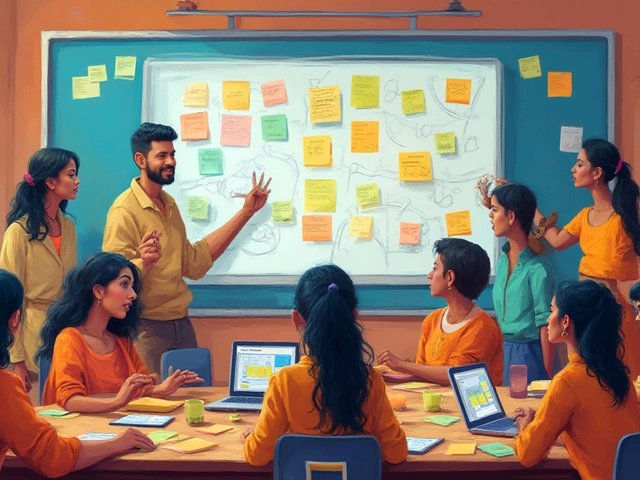Apr
3

- by Dhruv Ainsley
- 0 Comments
So, what exactly is an eLearning system? It's like having a digital classroom at your fingertips, letting you study pretty much whatever you want from the comfort of your home—or anywhere else, for that matter. Instead of being locked into a traditional classroom schedule, you get to choose when and where you learn. This makes it super handy for anyone juggling work, family, or other commitments.
Think of eLearning platforms like Netflix for education. You have a library of courses and resources ready to be accessed whenever you feel like diving into a topic. And the range is massive, offering everything from professional skills to hobbyist classes.
- Understanding eLearning Systems
- Types of eLearning Platforms
- Benefits of eLearning Systems
- Challenges and Solutions
- Tips for Choosing the Right eLearning System
Understanding eLearning Systems
Diving into eLearning systems is like opening a gateway to a world where education no longer means sitting in a classroom all day. These systems are digital platforms that offer educational courses and resources online. They've transformed the traditional learning process into something more flexible and interactive.
So, what makes up an eLearning system? At the core, it combines software tools that deliver information, track learning progress, and manage different educational tasks. Think Learning Management Systems (LMS) like Moodle or Blackboard. These are the backbone of many eLearning environments, helping teachers upload coursework, quizzes, and forums.
Then there's the content aspect itself. Platforms such as Coursera or Udemy offer a wide variety of courses in everything from programming to painting. This diversity means you can pick and choose what to learn, customizing your education to fit your goals.
A cool thing about online education is the inclusion of multimedia elements. Videos, quizzes, interactive assignments—you name it. These features engage learners more effectively compared to monotonous reading or attending dull lectures.
Worried about the completion rates or how effective it really is? According to some reports, courses with interactive content can double learner engagement. Engaged students are more likely to finish their courses and retain the information better.
Lastly, it's all about accessibility. eLearning systems break down the barriers of location and often cost. Whether you’re in a bustling city or a remote village, you’ve got access to top-notch education, sometimes even for free or at a fraction of the cost of traditional schooling.
Types of eLearning Platforms
Diving into the world of eLearning systems, you're bound to come across a variety of platforms, each catering to different needs. Let's break down the main types, so you can find the perfect fit for your learning journey.
First, there are Learning Management Systems (LMS). Think of these as the backbone of online education. An LMS is where courses are created, stored, and accessed. Some popular ones you might have heard of are Moodle, Blackboard, and Canvas. They're widely used by universities and big corporations to manage course content and track progress.
Then you've got Virtual Learning Environments (VLEs). These are similar to LMS but more focused on creating interactive spaces. VLEs like Google Classroom and Microsoft Teams bring a social aspect to learning, offering tools like chat rooms and forums where students and teachers can interact just like in a regular classroom.
Next up are MOOC platforms, which stands for Massive Open Online Courses. These burst onto the scene with the promise of making education accessible to everyone, everywhere. Platforms like Coursera and edX offer courses from top universities worldwide, allowing anyone to enroll and learn on a massive scale.
Self-paced online learning portals come into play for folks who prefer learning at their own speed. Services like Udemy and Skillshare provide a marketplace for learners to find courses on various topics, from graphic design to coding—all ready to be taken at your own pace.
Lastly, we have mobile learning apps. In this age of smartphones, platforms like Duolingo and Khan Academy make it super convenient to squeeze in learning during a commute or lunch break. They're designed with mobile users in mind and often include gamified experiences to keep you engaged.
- Learning Management Systems (LMS) - Moodle, Blackboard
- Virtual Learning Environments (VLEs) - Google Classroom, Microsoft Teams
- Massive Open Online Courses (MOOCs) - Coursera, edX
- Self-paced Learning Portals - Udemy, Skillshare
- Mobile Learning Apps - Duolingo, Khan Academy
With all these options out there, picking the right eLearning platform can be a game-changer for your educational or professional goals. Whether you crave the structure of traditional settings or the flexibility of self-paced study, there's an option just waiting for you.

Benefits of eLearning Systems
There's a bunch of reasons why eLearning systems have taken the world by storm. For starters, they’re super convenient. You know how busy life can get, right? With online education, you can squeeze in a lesson before breakfast or dive into a course late at night. You're the boss of your own schedule.
Another big plus is the range of courses on offer. Want to learn coding, brush up on history, or finally tackle that foreign language? There's probably an eLearning platform for that. It’s like having a whole university bundled up in your laptop.
And let’s talk savings. Compared to traditional education, these systems typically cost less. Forget about commuting or relocating to an expensive city just to be near a good school. Plus, many platforms offer free courses or trials to get you started without breaking the bank.
There's also something cool about how these systems keep evolving. For many people, the use of interactive media like videos and quizzes makes learning more engaging compared to the usual textbook method. This isn’t just sitting around reading—it’s an interactive adventure.
Let’s not forget about accessibility. People with different learning needs often find digital learning more accommodating than traditional methods. Whether you're hearing impaired, have difficulty with mobility, or require alternate formats, eLearning can provide options to fit your needs.
Check out this table showing how eLearning stacks up against traditional education:
| Aspect | Traditional Education | eLearning Systems |
|---|---|---|
| Cost | High | Generally Lower |
| Flexibility | Limited | High |
| Accessibility | Varies | Wide Options |
| Course Variety | Set by Institution | Vast Choices Online |
In essence, eLearning systems bring flexibility, affordability, and a world of knowledge right to your doorstep. It’s no surprise so many people are jumping on the bandwagon.
Challenges and Solutions
Diving into the world of eLearning systems can be super exciting, but it's not all rainbows and sunshine. There are some hurdles that both learners and educators face, but the good news is there are ways to tackle them.
One of the big challenges is the lack of face-to-face interaction. It can be tough to stay motivated when you're not physically in a classroom. To overcome this, some online education platforms integrate live sessions or interactive forums where you can connect with fellow learners and instructors. It might not be in-person, but it's a step closer.
Another issue is technology glitches. Ever been stuck in the middle of a course because of a lost connection or glitchy platform? It's super frustrating. A reliable internet connection is a must-do, but eLearning platforms are constantly updating their resources to minimize technical issues. Keeping your software updated and reaching out for tech support can save your day.
Then there's the overload of information. With so many courses available, choosing the right one can feel like a maze. Stick to platforms that offer course previews or trials, so you can get a taste before diving in full-fledged. Also, reviews and ratings from other users can be a treasure trove of insights.
Lack of self-discipline is a common trap when the freedom of learning at your own pace turns into procrastination. Setting a schedule and sticking to it can help. Use digital tools like reminders on your phone or calendar alerts to keep you on track.
Lastly, there's the concern about the quality of content. Not every course is created equal. Look for platforms that have partnerships with reputable institutions or offer certified courses to ensure you're getting credible information.
Here's a quick rundown of common issues and their fixes:
- Lack of Interaction: Engage in forums or live sessions.
- Tech Glitches: Keep software updated, and get proper support.
- Information Overload: Use course previews, check reviews.
- Discipline: Set specific goals, and use reminders.
- Content Quality: Choose certified platforms or partnerships with trusted institutions.
Sure, there are bumps along the way, but with these solutions, you'll be zipping through your learning platform experience in no time!

Tips for Choosing the Right eLearning System
Picking the right eLearning system can feel like a big task, but it doesn't have to be a headache. Here are some solid tips to steer you in the right direction.
First off, think about what you really need from an online education platform. Are you after a specific course? Or are you more interested in a wide variety of subjects? Look for platforms that match your learning goals.
Next, consider the user interface. If a platform looks like it's from the '90s, it might not be the best choice. Modern, intuitive design not only looks better but usually means it's easier to use. Try exploring the demo versions before committing.
According to Sarah Mintz, an educational technologist, “An eLearning platform should offer adaptability, making the learning process smoother and more effective.”
An eLearning platform should offer adaptability, making the learning process smoother and more effective.
Check what type of support is on offer. Whether it's tech support or help with course content, reliable support can be a lifesaver when you hit a snag.
Also, don’t overlook costs. Many platforms have free options or trials, so take advantage of those before whipping out your credit card.
- Ensure the platform is mobile-friendly. With everyone on their phones these days, a platform you can access on-the-go is crucial.
- Look for platforms with community features like forums or discussion groups. Learning gets way more engaging when you’re not alone.
- Check user reviews and ratings. Real feedback from other learners can give you a clearer picture of what to expect.
Finally, remember that some platforms focus on digital learning for specific industries or skills. If you're looking to beef up your resume, these might offer certifications that are recognized in your field.





